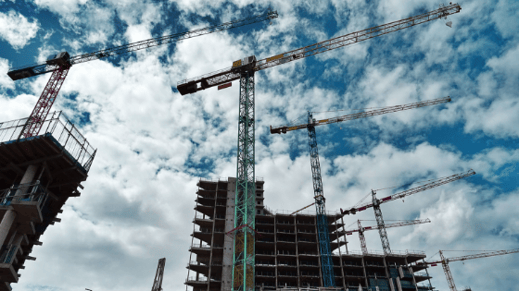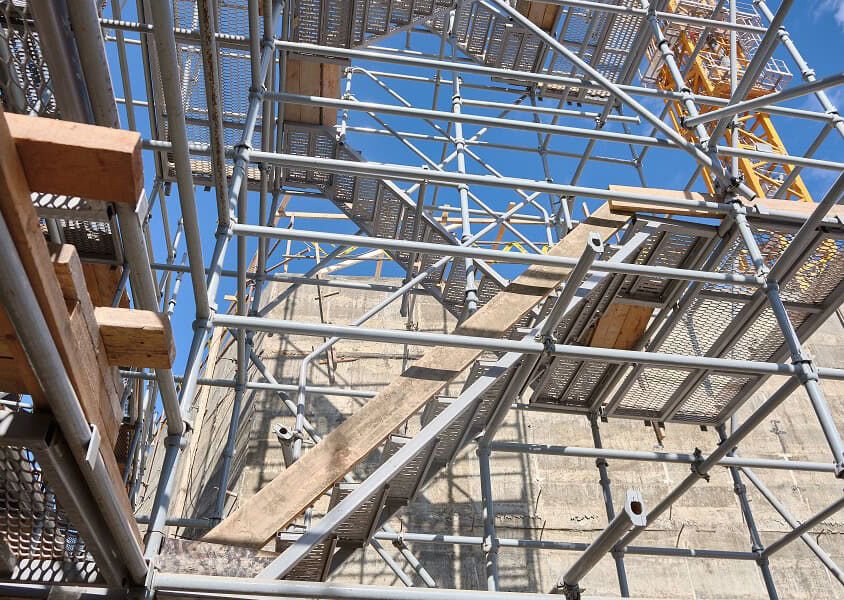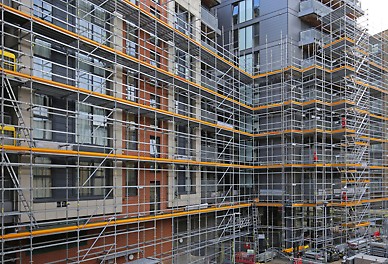A Comprehensive Guide to the Essential Features of Scaffolding in Modern Building And Construction
The landscape of contemporary building significantly depends on effective scaffolding systems that focus on effectiveness, innovation, and security. As tasks grow in complexity, understanding the necessary features of scaffolding ends up being essential for making sure employee safety and optimizing task timelines. This guide checks out numerous types of scaffolding, highlights key safety and security features, and takes a look at product developments that add to performance and sustainability. The implications of these elements extend much beyond plain building and construction techniques, triggering a better look at just how they affect total project success and employee health.
Sorts Of Scaffolding
Although scaffolding systems can vary widely in layout and application, they usually drop right into a number of unique categories that deal with different building needs - Scaffolding. One of the most typical types include supported scaffolding, put on hold scaffolding, and rolling scaffolding
Supported scaffolding is composed of systems supported by a framework of posts, which supply a raised and steady working surface area. This type is typically used for jobs that need substantial altitude, such as bricklaying or exterior paint.
Put on hold scaffolding, alternatively, is used for tasks requiring accessibility to high altitudes, such as cleaning or fixing building facades. This system hangs from a roof or one more framework, allowing workers to lower or elevate the platform as needed.
Rolling scaffolding features wheels that enable simple flexibility across a job site. It is specifically useful for tasks that need constant moving, such as indoor operate in large areas.
Each kind of scaffolding is made with particular applications in mind, making certain that construction projects can be accomplished efficiently and successfully. Recognizing these groups is essential for choosing the appropriate scaffolding system to satisfy both job demands and website problems.
Key Security Functions
Safety and security is extremely important in scaffolding systems, as the possible dangers related to working at elevations can lead to severe mishaps if not properly handled. Trick security functions are necessary to ensure the well-being of employees and the honesty of the construction site.
Primarily, guardrails are critical. These barriers give a physical protect against falls, significantly lowering the risk of serious injuries. In addition, toe boards are usually made use of to stop tools and materials from dropping off the scaffold, securing workers below.
One more vital part is the usage of non-slip surfaces on systems. This attribute improves grip, specifically in adverse weather, thereby lessening the possibility of drops and slips. In addition, gain access to ladders should be safely placed to assist in safe entrance and exit from the scaffold.
Normal assessments and upkeep of scaffolding systems are also essential. These evaluations guarantee that all parts are in excellent condition and operating appropriately, dealing with any kind of wear or damage immediately.
Last but not least, proper training for all workers included in scaffolding operations is crucial to make sure that they understand security procedures and can recognize prospective hazards. Scaffolding. Collectively, these functions develop a safer working atmosphere and significantly reduce dangers linked with scaffolding
Product Innovations
Improvements in product scientific research have considerably affected the scaffolding industry, enhancing both security and effectiveness in contemporary building and construction. The introduction of high-strength steel and aluminum alloys has reinvented typical scaffolding systems. These products are not only lighter, making them simpler to construct and move, yet additionally give remarkable load-bearing capacities. This causes scaffolding structures that can support scaffolding theory higher weights while reducing the risk of collapse.
Additionally, innovative composite products, such as fiberglass-reinforced plastics, have actually arised as sensible options. These materials are immune to deterioration and ecological deterioration, thus expanding the life expectancy of scaffolding systems, specifically in harsh climate conditions. Using such products adds to decrease maintenance costs and makes certain constant efficiency over time.


Design Factors To Consider
Thinking about the complexities of modern building and construction jobs, efficient scaffolding style is paramount to ensuring both capability and security. Style considerations have to incorporate different factors, consisting of lots capability, height, and why not find out more the details demands of the construction website. Each task provides unique obstacles, requiring a flexible approach to scaffolding systems that can adjust to varying problems.
Structural stability is Website important; as a result, engineers need to calculate the tons that the scaffolding will certainly support, consisting of workers, products, and equipment. The option of materials plays a crucial function in ensuring the scaffolding can stand up to these lots while remaining resilient and light-weight. Additionally, the style must enable easy gain access to and egress, promoting the smooth movement of employees and materials.
Safety functions, such as guardrails and non-slip surface areas, ought to be integrated to decrease risks of mishaps. The layout must take into consideration the surrounding setting, including possible threats and adjacent structures. By resolving these design considerations, construction firms can improve the efficiency of scaffolding systems and promote a much safer working atmosphere, eventually adding to the general success of the project.
Upkeep and Assessments
The efficiency of scaffolding systems prolongs past preliminary design and implementation; ongoing maintenance and regular inspections are essential to guaranteeing their proceeded performance and security throughout the duration of a project. Normal evaluations ought to be conducted by qualified employees to recognize any indicators of wear, damages, or instability that might jeopardize the integrity of the scaffolding.
Maintenance protocols should consist of regular checks of structural components, such as installations, planks, and frames, making certain that all elements remain cost-free and protected from corrosion or other wear and tear. In addition, the performance of safety attributes, such as guardrails and toe boards, should be examined to make sure compliance with security regulations.
Documents of all evaluations and upkeep tasks is essential for liability and regulatory conformity. A systematic approach to record-keeping not only help in tracking the condition of the scaffolding however also offers essential evidence in the occasion of a case.
Eventually, establishing a comprehensive maintenance and examination schedule will substantially reduce the threat of mishaps and boost the overall safety of the building and construction website. By focusing on these methods, building and construction managers can protect employees and promote the task's integrity.

Conclusion
In final thought, the vital functions of scaffolding in contemporary construction encompass a series of essential components, consisting of diverse types, vital safety devices, product innovations, and thoughtful layout considerations. Highlighting safety through guardrails and non-slip surface areas, together with developments in materials like high-strength steel, improves both performance and sustainability. Furthermore, normal maintenance and inspections are essential for guaranteeing structural honesty and security on construction websites, ultimately assisting in effective project implementation and promoting the health of workers.
The landscape of contemporary building and construction progressively counts on reliable scaffolding systems that prioritize safety, advancement, and effectiveness.Advancements in product science have substantially affected the scaffolding industry, enhancing both safety and security and effectiveness in modern construction. Generally, these product technologies not just boost the performance and security of scaffolding systems however additionally line up with the industry's press towards sustainability, as several modern-day materials are made to be extra eco pleasant.
Considering the complexities of modern construction tasks, reliable scaffolding layout is extremely important to ensuring both functionality and safety.In final thought, the crucial attributes of scaffolding in modern-day building and construction include a variety of vital components, consisting of varied kinds, essential safety mechanisms, material developments, and thoughtful design considerations.